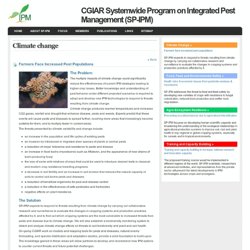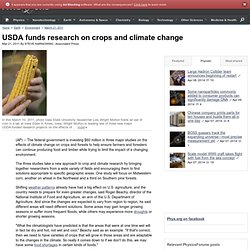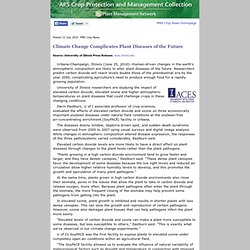

Le réchauffement menace un tiers des animaux et la moitié des végétaux. LE MONDE | • Mis à jour le | Par Stéphane Foucart Des oiseaux, des mammifères, des reptiles, des arbres, des plantes herbacées… En inventoriant les aires de répartition de 48 786 espèces animales et végétales, une équipe internationale conduite par Rachel Warren (Université d'East Anglia, Royaume-Uni) tente de chiffrer le risque d'érosion de la biodiversité dû au changement climatique en cours.

Ces travaux, publiés lundi 13 mai dans la revue Nature Climate Change, permettent, pour la première fois, d'estimer les bénéfices des mesures de lutte contre le dérèglement climatique. Les résultats, obtenus grâce à une combinaison de modèles de simulation du climat, sont éloquents. Sans réduction des émissions de gaz à effet de serre, les chercheurs prévoient que, d'ici à 2080, environ 55 % des végétaux et 35 % des animaux auront perdu plus de la moitié de leur zone cli... IMPACT DES BIOTECHNOLOGIES VEGETALES SUR LE CHANGEMENT CLIMATIQU. Invitation Colloque Vulnérabilité des forêts 17nov11.pdf (Objet application/pdf) Av_40_french.pdf (Objet application/pdf) Climate change: potential impact on plant diseases. [Environ Pollut. 2000] - PubMed result.
Australasian Plant Pathology, Volume 27, Number 1. Farmers Face Increased Pest Populations - Climate change - SP-IPM. The Problem The multiple impacts of climate change could significantly reduce the effectiveness of current IPM strategies leading to higher crop losses.

Better knowledge and understanding of pest behavior under different projected scenarios is required to adopt and develop new IPM technologies to respond to threats resulting from climate change. Climate change produces warmer temperatures and increases CO2 gases, rainfall and drought that enhance disease, pests and weeds. Experts predict that these events will cause pests and diseases to spread further, covering more areas that increasingly become suitable for them, and to multiply faster in current areas. The threats presented by climate variability and change include: The Solution The knowledge gained in these areas will allow partners to develop and recommend new IPM options to counter current threats and future potential challenges. PROD2008d0be8eb_20080625041803219.pdf (Objet application/pdf)
1_09_005.PDF (Objet application/pdf) Boland et al (2004).pdf (Objet application/pdf) Objet application/pdf) Giraud_TREE_2010.pdf (Objet application/pdf) Climate change complicates plant diseases of the future. Human-driven changes in the earth's atmospheric composition are likely to alter plant diseases of the future.

Researchers predict carbon dioxide will reach levels double those of the preindustrial era by the year 2050, complicating agriculture's need to produce enough food for a rapidly growing population. University of Illinois researchers are studying the impact of elevated carbon dioxide, elevated ozone and higher atmospheric temperatures on plant diseases that could challenge crops in these changing conditions. Darin Eastburn, U of I associate professor of crop sciences, evaluated the effects of elevated carbon dioxide and ozone on three economically important soybean diseases under natural field conditions at the soybean-free air-concentrating enrichment (SoyFACE) facility in Urbana. The diseases downy mildew, Septoria brown spot, and sudden death syndrome were observed from 2005 to 2007 using visual surveys and digital image analysis.
USDA funds research on crops and climate change. (AP) -- The federal government is investing $60 million in three major studies on the effects of climate change on crops and forests to help ensure farmers and foresters can continue producing food and timber while trying to limit the impact of a changing environment.

The three studies take a new approach to crop and climate research by bringing together researchers from a wide variety of fields and encouraging them to find solutions appropriate to specific geographic areas. One study will focus on Midwestern corn, another on wheat in the Northwest and a third on Southern pine forests. Shifting weather patterns already have had a big effect on U.S. agriculture, and the country needs to prepare for even greater changes, said Roger Beachy, director of the National Institute of Food and Agriculture, an arm of the U.S. Department of Agriculture. And since the changes are expected to vary from region to region, he said different areas will need different solutions. Get_file (Objet application/pdf) Climate change and plant disease management.pdf (Objet application/pdf) GarrettDendy2006ARP.pdf (Objet application/pdf) Summary_jeger_cphr_conference.pdf (Objet application/pdf)
Presentation_jeger_cphr_conference.pdf (Objet application/pdf) HT2008Mogens.pdf (Objet application/pdf) 13961.pdf (Objet application/pdf) 13964.pdf (Objet application/pdf) 2010_WS3.1_Luck.pdf (Objet application/pdf) Get_file (Objet application/pdf) Climate Change Complicates Plant Diseases of the Future. Climate Change Complicates Plant Diseases of the Future Urbana-Champaign, Illinois (June 25, 2010)--Human-driven changes in the earth's atmospheric composition are likely to alter plant diseases of the future.

Researchers predict carbon dioxide will reach levels double those of the preindustrial era by the year 2050, complicating agriculture's need to produce enough food for a rapidly growing population. University of Illinois researchers are studying the impact of elevated carbon dioxide, elevated ozone and higher atmospheric temperatures on plant diseases that could challenge crops in these changing conditions. Darin Eastburn, U of I associate professor of crop sciences, evaluated the effects of elevated carbon dioxide and ozone on three economically important soybean diseases under natural field conditions at the soybean-free air-concentrating enrichment (SoyFACE) facility in Urbana. In elevated ozone, plant growth is inhibited and results in shorter plants with less dense canopies. Effets du changement climatique sur les ravageurs. The World AgroMeteorological Information Service.
S3-Torresen.pdf (Objet application/pdf)